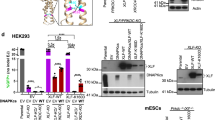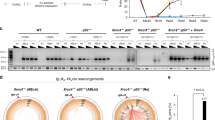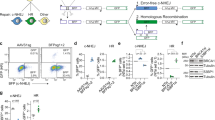Abstract
Nonhomologous end-joining (NHEJ) of DNA double-strand breaks (DSBs) entails two principal mechanisms: modification of DNA ends prior to ligation (error-prone rejoining) or precise ligation without modification if the DNA ends are complementary (error-free repair). Error-prone rejoining is mutagenic, because it can lead to destruction of coding sequence or to chromosomal aberrations, and therefore must be tightly regulated. Previous studies on the role of the p53 tumor suppressor in the regulation of NHEJ have yielded conflicting results, but a rigorous analysis of NHEJ proficiency and fidelity in a purely chromosomal context has not been carried out. To this end, we created novel repair plasmid substrates that integrate into the genome. DSBs generated by the I-SceI endonuclease within these substrates were repaired by either error-prone rejoining or precise ligation. We found that the expression of wild-type p53 inhibited any repair-associated DNA sequence deletion, including a more than 250-fold inhibition of error-prone rejoining events compared to p53-null cells, while any promoting effect of p53 on precise ligation could not be directly evaluated. The role of p53 in NHEJ appeared to involve a direct transactivation-independent mechanism, possibly restricting DNA end-modification by blocking the annealing of single strands along flanking stretches of microhomology. The inhibition of error-prone rejoining by p53 did not apply to the rejoining of DSBs induced by ionizing radiation. In conclusion, our data suggest that p53 restricts the mutagenic effects of NHEJ without compromising repair proficiency or cell survival, thereby maintaining genomic stability.
This is a preview of subscription content, access via your institution
Access options
Subscribe to this journal
Receive 50 print issues and online access
$259.00 per year
only $5.18 per issue
Buy this article
- Purchase on Springer Link
- Instant access to full article PDF
Prices may be subject to local taxes which are calculated during checkout






Similar content being viewed by others
References
Achanta G, Pelicano H, Feng L, Plunkett W and Huang P . (2001). Cancer Res., 61, 8723–8729.
Akyüz N, Boehden GS, Susse S, Rimek A, Preuss U, Scheidtmann KH and Wiesmüller L . (2002). Mol. Cell. Biol., 22, 6306–6317.
Allen C, Miller CA and Nickoloff JA . (2003). DNA Repair, 2, 1147–1156.
Bill CA, Yu Y, Miselis NR, Little JB and Nickoloff JA . (1997). Mutation Res., 385, 21–29.
Boehden GS, Akyuz N, Roemer K and Wiesmuller L . (2003). Oncogene, 22, 4111–4117.
Böhnke A, Westphal F, Schmidt A, El-Awady RA and Dahm-Daphi J . (2004). Int. J. Radiat. Biol., 80, 53–63.
Brosh Jr RM, Karmakar P, Sommers JA, Yang Q, Wang XW, Spillare EA, Harris CC and Bohr VA . (2001). J. Biol. Chem., 276, 35093–35102.
Bryant PE, Birch DA and Jeggo PA . (1987). Int. J. Radiat. Biol., 52, 537–554.
Carbone R, Pearson M, Minucci S and Pelicci PG . (2002). Oncogene, 21, 1633–1640.
Chang C, Biedermann KA, Mezzina M and Brown JM . (1993). Cancer Res., 53, 1244–1248.
Dahm-Daphi J . (2000). Strahlenther Onkol., 176, 278–285.
Dahm-Daphi J, Brammer I and Dikomey E . (1997). Int. J. Radiat. Biol., 72, 171–179.
DiBiase SJ, Guan J, Curran Jr WJ and Iliakis G . (1999). Int. J. Radiat. Oncol. Biol. Phys., 45, 743–751.
Difilippantonio MJ, Zhu J, Chen HT, Meffre E, Nussenzweig MC, Max EE, Ried T and Nussenzweig A . (2000). Nature, 404, 510–514.
Dikomey E, Dahm-Daphi J, Brammer I, Martensen R and Kaina B . (1998). Int. J. Radiat. Biol., 73, 269–278.
Dudenhoffer C, Rohaly G, Will K, Deppert W and Wiesmuller L . (1998). Mol. Cell. Biol., 18, 5332–5342.
El-Awady RA, Dikomey E and Dahm-Daphi J . (2003). Br. J. Cancer, 89, 593–601.
Ferguson DO, Sekiguchi JM, Chang S, Frank KM, Gao Y, DePinho RA and Alt FW . (2000). Proc. Natl. Acad. Sci. USA, 97, 6630–6633.
Gao Y, Ferguson DO, Xie W, Manis JP, Sekiguchi J, Frank KM, Chaudhuri J, Horner J, DePinho RA and Alt FW . (2000). Nature, 404, 897–900.
Guirouilh-Barbat J, Huck S, Bertrand P, Pirzio L, Desmaze C, Sabatier L and Lopez BS . (2004). Mol. Cell, 14, 611–623.
Henner WD, Rodriguez LO, Hecht SM and Haseltine WA . (1983). J. Biol. Chem., 258, 711–713.
Hoeijmakers JH . (2001). Nature, 411, 366–374.
Huang P . (1998). Oncogene, 17, 261–270.
Iwabuchi K, Basu BP, Kysela B, Kurihara T, Shibata M, Guan D, Cao Y, Hamada T, Imamura K, Jeggo PA, Date T and Doherty AJ . (2003). J. Biol. Chem., 278, 36487–36495.
Izumi T, Wiederhold LR, Roy G, Roy R, Jaiswal A, Bhakat KK, Mitra S and Hazra TK . (2003). Toxicology, 193, 43–65.
Lee JW, Blanco L, Zhou T, Garcia-Diaz M, Bebenek K, Kunkel TA, Wang Z and Povirk LF . (2004). J. Biol. Chem., 279, 805–811.
Levine AJ . (1997). Cell, 88, 323–331.
Lieber MR, Ma Y, Pannicke U and Schwarz K . (2004). DNA Repair, 3, 817–826.
Lin Y, Waldman BC and Waldman AS . (2003). DNA Repair, 2, 1–11.
Liu LF, Rowe TC, Yang L, Tewey KM and Chen GL . (1983). J. Biol. Chem., 258, 15365–15370.
Ma JL, Kim EM, Haber JE and Lee SE . (2003). Mol. Cell. Biol., 23, 8820–8828.
Ma V, Pannicke U, Schwarz K and Lieber M . (2002). Cell, 108, 781–794.
Mahajan KN, Nick McElhinny SA, Mitchell BS and Ramsden DA . (2002). Mol. Cell. Biol., 22, 5194–5202.
Meek DW . (2004). DNA Repair, 3, 1049–1056.
Mummenbrauer T, Janus F, Muller B, Wiesmuller L, Deppert W and Grosse F . (1996). Cell, 85, 1089–1099.
Offer H, Milyavsky M, Erez N, Matas D, Zurer I, Harris CC and Rotter V . (2001). Oncogene, 20, 581–589.
Okorokov AL, Warnock L and Milner J . (2002). Carcinogenesis, 23, 549–557.
Pfeiffer P, Goedecke W and Obe G . (2000). Mutagenesis, 15, 289–302.
Pfeiffer P, Thode S, Hancke J and Vielmetter W . (1994). Mol. Cell. Biol., 14, 888–895.
Pierce AJ, Hu P, Han M, Ellis N and Jasin M . (2001). Genes Dev., 15, 3237–3242.
Powell SN, DeFrank JS, Connell P, Eogan M, Preffer F, Dombkowski D, Tang W and Friend S . (1995). Cancer Res., 55, 1643–1648.
Richardson C, Moynahan ME and Jasin M . (1998). Genes Dev., 12, 3831–3842.
Rogers-Bald M, Sargent RG and Bryant PE . (2000). Int. J. Radiat. Biol., 76, 23–29.
Romanova LY, Willers H, Blagosklonny MV and Powell SN . (2004). Oncogene, 23, 9025–9033.
Saintigny Y, Rouillard D, Chaput B, Soussi T and Lopez BS . (1999). Oncogene, 18, 3553–3563.
Sionov RV and Haupt Y . (1999). Oncogene, 18, 6145–6157.
Skalski V, Lin ZY, Choi BY and Brown KR . (2000). Oncogene, 19, 3321–3329.
Tang W, Willers H and Powell SN . (1999). Cancer Res., 59, 2562–2565.
Vilenchik MM and Knudson AG . (2003). Proc. Natl. Acad. Sci. USA, 100, 12871–12876.
Willers H, Dahm-Daphi J and Powell SN . (2004). Br. J. Cancer, 90, 1297–1301.
Willers H, McCarthy EE, Hubbe P, Dahm-Daphi J and Powell SN . (2001). Carcinogenesis, 22, 1757–1763.
Willers H, McCarthy EE, Wu B, Wunsch H, Tang W, Taghian DG, Xia F and Powell SN . (2000). Oncogene, 19, 632–639.
Yang T, Namba H, Hara T, Takmura N, Nagayama Y, Fukata S, Ishikawa N, Kuma K, Ito K and Yamashita S . (1997). Oncogene, 14, 1511–1519.
Zhang J, Willers H, Feng Z, Ghosh JC, Kim S, Weaver DT, Chung JH, Powell SN and Xia F . (2004). Mol. Cell. Biol., 24, 708–718.
Acknowledgements
We thank Dr Fen Xia and the members of their labs for critical review of the manuscript, Drs Maria Jasin and Heiner Küpper for their generous contribution of plasmids, and Lena Schliecker for technical assistance. This work was supported by a grant from the Deutsche Krebshilfe (German Cancer Aid) to JDD (10-1843-Da) and a grant from the NCI/NIH to SNP (R01 CA58985).
Author information
Authors and Affiliations
Corresponding author
Rights and permissions
About this article
Cite this article
Dahm-Daphi, J., Hubbe, P., Horvath, F. et al. Nonhomologous end-joining of site-specific but not of radiation-induced DNA double-strand breaks is reduced in the presence of wild-type p53. Oncogene 24, 1663–1672 (2005). https://doi.org/10.1038/sj.onc.1208396
Received:
Revised:
Accepted:
Published:
Issue Date:
DOI: https://doi.org/10.1038/sj.onc.1208396



